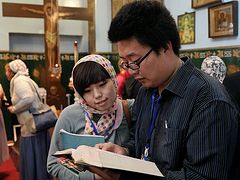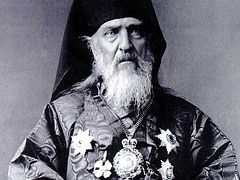 On August 1, 1836, in the village of Beryoza, Smolensk District, a son was born into the family of a poor deacon named Dimitry Kasatkin. The child was Baptized with the name Ivan. Who then could have imagined that Vanya Kasatkin would become the third Russian (i.e., after the Holy Princess Olga and Holy Prince Vladimir) to be glorified as a Saint Equal-to-the-Apostles! When in 1860 the 24-year-old missionary set off for Japan, preaching the Gospel in that country seemed absolutely inconceivable. According to Fr. Nicholas, “the Japanese looked upon foreigners as animals and upon Christianity as an extremely evil church to which only obvious evildoers and sorcerers could belong.” Apparently, the early years of his mission served only to confirm that sad idea: after eight years, the Russian missionary’s flock in Japan consisted of a mere twelve people. Toward the end of his life, however, in Japan there were already 266 communities, with a bishop, an archbishop, thirty-five priests, 116 preachers, and approximately 33,000 laypeople!
On August 1, 1836, in the village of Beryoza, Smolensk District, a son was born into the family of a poor deacon named Dimitry Kasatkin. The child was Baptized with the name Ivan. Who then could have imagined that Vanya Kasatkin would become the third Russian (i.e., after the Holy Princess Olga and Holy Prince Vladimir) to be glorified as a Saint Equal-to-the-Apostles! When in 1860 the 24-year-old missionary set off for Japan, preaching the Gospel in that country seemed absolutely inconceivable. According to Fr. Nicholas, “the Japanese looked upon foreigners as animals and upon Christianity as an extremely evil church to which only obvious evildoers and sorcerers could belong.” Apparently, the early years of his mission served only to confirm that sad idea: after eight years, the Russian missionary’s flock in Japan consisted of a mere twelve people. Toward the end of his life, however, in Japan there were already 266 communities, with a bishop, an archbishop, thirty-five priests, 116 preachers, and approximately 33,000 laypeople!
In 1855 Japan allowed the Russians to establish their first diplomatic mission, in Hakodate. In 1860 the Russian consul to Japan made a request of the Holy Synod to send a pastor “who might be useful not only with his religious
activities, but one who with his scholarly efforts and his personal life would be capable of giving the Japanese and foreigners as well a good
understanding of our clergy.” That request was passed on to the Theological Academy.
Among its graduates was John Kasatkin. Learning of the consul’s letter, John Kasatkin petitioned the rector to tonsure him a monk and appoint him to the Russian Consulate in Japan. There was no objection to his request. In June 1860, he was tonsured with the name Nicholas. The very same month, he was ordained a hieromonk, and became a monastic missionary. In July, the young hieromonk left for his assignment in the city of Hakodate, Japan. He later recollected, “I dreamed a lot about my Japan. I imagined it to be like a bride waiting for me with a floral bouquet in her hands. When news of Christ flooded through its darkness, everything would be renewed. How disillusioning it was for me to arrive in Japan and see the complete opposite of what I had imagined! I arrived, looked around, and saw that my bride was asleep, and was not even thinking about me.”
Since long ago, the Japanese had had a low opinion of everything foreign, and had held firmly to their own customs. Christian ethics were completely alien to the Japanese people. One can readily see that in the Samurai code: in the event of dishonor, the Samurai was obliged to committed suicide, to commit hara kiri. Of course, to them, Christians worshiping Christ, One who had been crucified, seemed simply horrible. Even more so was their affirmation that this person, who had been condemned to a disgraceful death, was God!
For eight years, the young missionary studied Japan. Everything interested him—its language, its customs, and its moral code. In 1868 he spoke rudimentary Japanese and acquired a better understanding of Japan’s history than did the Japanese themselves.
Among the first Japanese to be converted to Orthodoxy by Fr. Nicholas was Sawabe. That Saul-turned-Paul was a Shinto priest who was held in universal respect and lived in complete material contentment. He once happened to visit the Russian priest only to express his scorn for and hatred of the Christian Faith. He began his discussion with pointed ridicule, but in the course of the talk became progressively more reflective. The next day Sawabe returned, and at the conclusion of the discussion asked to begin studying Christian teachings. He brought a brush and ink to the first lesson. Fr. Nicholas would relate the story of the Old Testament, and Sawabe would record it in kanji hieroglyphs. One year later, Sawabe brought his friend Dr. Sakai to see Fr. Nicholas. Another year later, another physician, Dr. Urano, joined them. Much later, during their Baptism (Fr. Nicholas was in no hurry to baptize them, for he wanted to afford his disciples the opportunity to better learn and accept the truths of that new faith), they were given names of Apostles-Paul, James and John. In 1870, Fr. Nicholas was appointed director of the newly reestablished Japanese Orthodox Mission. In 1871, persecution against Christians began in that land. Paul Sawabe was incarcerated along with another eight Orthodox believers. Over one hundred people were called in for questioning.
Soon however, everything changed. The old anti-Christian directives were rescinded. Fr. Nicholas set about building churches and schools, and later, a religious school as well. He translated religious service books into Japanese, and compiled a glossary of theological terms. By then, there were already 4,000 believers. John Sakai was ordained a deacon. Five years later, Nicholas became the first bishop of Tokyo, where he erected the Cathedral Church of Christ’s Resurrection. The Russo-Japanese War began. In an epistle to the Japanese Orthodox, Holy Hierarch Nicholas wrote, “It pleased God to permit a rift between Russia and Japan. May His holy will be done… Brothers and sisters, do everything required of you as loyal citizens in these circumstances…” As a Russian patriot, he no longer served public Divine Services, at which prayers for Japanese victory had to be offered.
During the war, Fr. Nicholas was the only Russian at the Mission. He visited his compatriots who were prisoners of war, and did everything he could to assist them. Meanwhile, during the War, his Japanese flock grew ever larger. In 1905, 627 people were baptized!
In 1906, the Holy Hierarch was rewarded for his ascetic labors by being raised to the rank of Archbishop. Despite this clear evidence that the higher ecclesiastical authorities were well disposed toward him, he remained to the end of his days the image of absolute humility, never extolling himself over anyone in any way. The following words are recorded in his diary: “I bow down before glorious eldership, and reproach myself for my own, petty inspiration to work, and even in that, only that little work, without regard to everything else in the world. What poverty and narrowness of nature! I can see that I am of use only to Japan, to an insignificant corner of the world!”
On February 1, 1912, in his seventieth year, Holy Hierarch peacefully departed to the Lord. He became the first European to be buried in the ancient cemetery of Tokyo.
On April 10, 1970, the Russian Orthodox Church glorified the Holy Hierarch as a Saint. From his death to the present, St. Nicholas has been venerated in Japan as a great righteous one and prayerful intercessor before God. The Resurrection Cathedral in Tokyo is also known as “the church of St. Nicholas.”
O Holy Hierarch Fr. Nicholas, pray to God for us!




